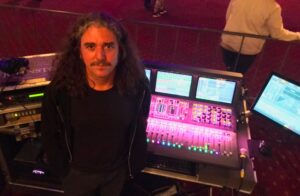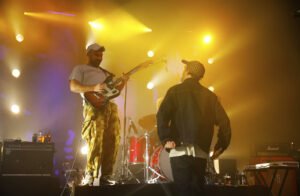Subscribe to CX E-News
Roadskills
The DMA’s
By Cat Strom.
Photos: David Youdell and BCS imaging
The DMA’s do not disappoint on their long awaited Australian tour

Jeff Hahn
With a sound and style heavily influenced by ’90s Britpop, it’s no surprise that Australian band The DMA’s are a big hit in the UK. Having just finished a 24-date run there, the band finally found time to return for an Australian tour selling out venues wherever they went.
FOH engineer Jeff Hahn has worked with the band for the past eighteen months, picking them up as his other main act Violent Soho wound down their touring cycle. However his ‘proper’ job is Production Manager at Brisbane’s Triffid, a position he has held since it opened in 2014.
“Luckily the venue owners know it’s important to have me out doing stuff with current acts and keeping my finger on the pulse,” added Jeff. “That way I can relate better to the touring techs and artists that come through the venue and know what’s really needed from a venue when you’re in their position.”
Jeff has generally been an Avid Profile man but for this tour he stepped up to the Avid Venue S6L saying he found the console very intuitive to use. “I had only used an S6L once before this tour but was immediately impressed with it from day one,” he said.
“The huge improvement in processing and pre amps add significantly more weight and headroom over the previous Venue consoles. Sonically it is certainly a big step up.” On the last Violent Soho tour Jeff took out a Midas XL4, partly to challenge himself but also he just wanted to use a great sounding console on those big PAs.
 “I’ve used every make and model of modern console and I feel that all the digital consoles I’ve ever used are compromised sonically for the sake of convenience and I just wanted it to sound as good as possible without that compromise. The S6L doesn’t sound as compromised to me; it sounds really good straight in and straight out with plug ins used for taste rather than being essential. Importantly, the channel EQ feels more musical to use than other digital consoles.”
“I’ve used every make and model of modern console and I feel that all the digital consoles I’ve ever used are compromised sonically for the sake of convenience and I just wanted it to sound as good as possible without that compromise. The S6L doesn’t sound as compromised to me; it sounds really good straight in and straight out with plug ins used for taste rather than being essential. Importantly, the channel EQ feels more musical to use than other digital consoles.”
Jeff had some outboard gear such as a Smart Research C2 compressor over left and right saying he really likes what they do to a mix.
“I’m only just touching the mix with it,” he added. “I always like having a good analogue compressor after a digital console, I prefer to run digital consoles pretty cool and then give it a kick on the way out than try to run them hot at the output stage. That’s always been my typical approach and I used it on this run partly to have something familiar at hand.”
A TC Electronic M5000 reverb unit was used as lush reverbs are a big feature in The DMA’s music especially on Tommy’s vocal.
“I use copious amounts of reverb on Tommy’s vocals, more than I’ve ever gotten away with before,” said Jeff. “It just sticks to his voice and helps to make it sit better out front. The more I put on it, the better it seems to get! He’s got a fairly unique tonal timbre to his voice that’s very open and throaty and the right reverb just sticks to it beautifully.”
Despite Tommy being a great singer, it’s always a challenge for Jeff to lift his vocal above the wall of sound on stage.
“He gives me plenty of level but it is dynamic music and the guitars swell at times producing a cacophonous wall of sound,” he explained. “The main vocal channel is the money channel, lose that in the mix and you’ll lose your gig pretty fast!
“They’re a very good sounding band and not hard to make sound good out front but I’m always working during the show, I have to constantly ride levels because you never really know what you’re going to get from night to night from the stage, especially with so many different combinations and stacking of gain stages on all of the bass and guitar effects.
“I do use some group sidechain compression to help with this; I sidechain the guitars off Tommy’s vocal just to duck them a couple of dB when he’s singing, it frees up a bit of room in the mix and helps keep his voice front and centre.”
Jeff tours all his own microphones with DMA’s preferring a blend of old and new models. On the kick and toms were Sennheiser MD421s, Shure 57s on snare top and bottom, an AKG 451 on hats and a RØDE NT4 stereo X/Y for overheads. All vocals were Sennheiser MD431s with Jeff commenting that it’s been his favourite vocal mic for a long time.
“They’re just a great sounding mic, as I was coming up and trying different combinations it was one of the few microphones that when put in front of them, experienced singers would often ask, what mic is this?,” he remarked.

“They have a lot of mid-range present in them and to my ears are a simple, natural sounding vocal microphone with a tight pattern and you can do with them tonally what you will. I have a Beyerdynamic M88 on bass which is a big part of the tone, the bass amp is about 60% of what comes out front with a REDDI tube DI and a Sans Amp making up the rest, guitars are all Sennheiser e906.”
The drummer utilizes hard wired IEMs and a sub with the rest of the band all on wedges, preferably M2s or M4s for Tommy, making for a loud stage. Monitor engineer Harrison Maher, on his first tour with the band, ran an Avid Profile.
In-house PA systems were used throughout the tour with the FOH control supplied by JPJ Audio for the east coast shows, Novatech for Adelaide and At Audio Technik did Perth.
This article first appeared in the July-August 2018 edition of CX Magazine New Zealand pp.45-48. CX Magazine is Australia and New Zealand’s only publication dedicated to entertainment technology news and issues. Read all editions for free or search our archive www.cxnetwork.com.au
© CX Media
Subscribe
Published monthly since 1991, our famous AV industry magazine is free for download or pay for print. Subscribers also receive CX News, our free weekly email with the latest industry news and jobs.





















